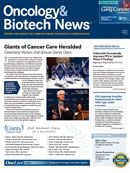Publication
Article
Oncology & Biotech News
IDH2 Inhibitor Shows Promise in AML
Author(s):
An early study presented at the 2014 AACR Annual Meeting showed promise for a new targeted therapy for acute myeloid leukemia
Eytan M. Stein, MD
An early study presented at the 2014 AACR Annual Meeting showed promise for a new targeted therapy for acute myeloid leukemia (AML). The drug, called AG-221 (Agios), is targeted to the isocitrate dehydrogenase- 2 (IDH2)-mutant protein expressed in AML.
In a phase I study, responses were observed in six of seven AML patients: three had complete hematologic responses, two had complete responses without platelet recovery, and one had a partial response. Three more patients are being evaluated for response to AG-221.
Even though this was a small, early trial, experts were quite enthusiastic about these responses. “To get this kind of response with a drug that is not nearly as toxic as chemotherapy is exciting. These patients are refractory AML even after transplant and have ominous disease. The data are still preliminary, but this is a selected drug against a mutated target.
All I can say is ‘wow’,” said Patricia LoRusso, DO, Karmanos Cancer Institute in Detroit, who moderated a press conference where these data were discussed.
“These patients have no good treatment options. We give them chemotherapy but it is not very effective and has substantial toxicity. AG-221 represents the opportunity to treat them in a way that doesn’t compromise their immune system. These responses are kind of unheard of in AML,” said lead author Eytan M. Stein, MD, Memorial Sloan Kettering Cancer Center.
Stein said that the study results validate the idea that blocking mutant IDH2 results in a dramatic decrease in the oncometabolite 2-HG, an abnormal substance produced by mutant IDH2 that interferes with normal maturation of bone marrow cells.
The study has enrolled 22 patients with IDH2-mutant positive disease, and 16 remained on study at the time of the AACR meeting. Twenty-one had AML and one had myelodysplastic syndrome.
Cohorts of five to seven patients each were treated with AG-221 in continuous oral daily dosing in 28-day cycles at doses ranging from 30 to 75 mg twice daily or 100 mg once daily. No dose-limiting toxicities have been identified thus far. The group is still evaluating doses of 75 mg twice daily and 100 mg once daily, and will continue to escalate until they identify a maximum-tolerated dose, Stein said.
Pharmacokinetic/ pharmacodynamics data showed that the drug accumulated to high levels after multiple doses, and this was associated with greater than 90% inhibition of plasma 2-HG.
Two possibly drug-related serious adverse events were reported: one grade 2 hyperleukocytosis and differentiation syndrome and one grade 3 confusion and respiratory failure in a patient with sepsis. Four patients died within 30 days of study drug termination, all from complications of disease-related sepsis.
Stein said that the dose expansion cohorts will be studied later in the year. He also said that if all goes well, the drug will be studied earlier in the course of the disease process and in combination with other therapies, using the plasma level of 2-HG as a biomarker.
Stein E, Tallman M, Pollyea DA, et al. Clinical safety and activity in a Phase I tr ial of AG-221, a first in class, potent inhibitor of the IDH2-mutant protein, in patients with IDH2 mutant positive advanced hematologic malignancies. Presented at: 2014 AACR Annual Meeting; April 5-9, 2014; San Diego, CA. Abstract CT103.










